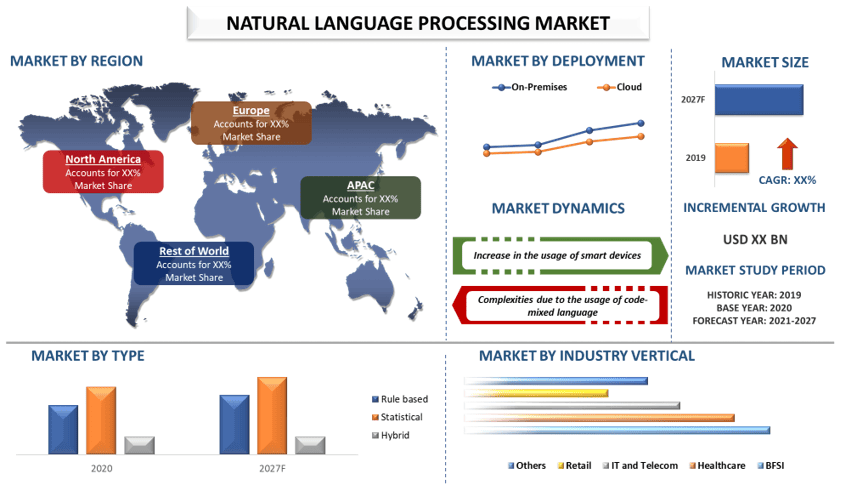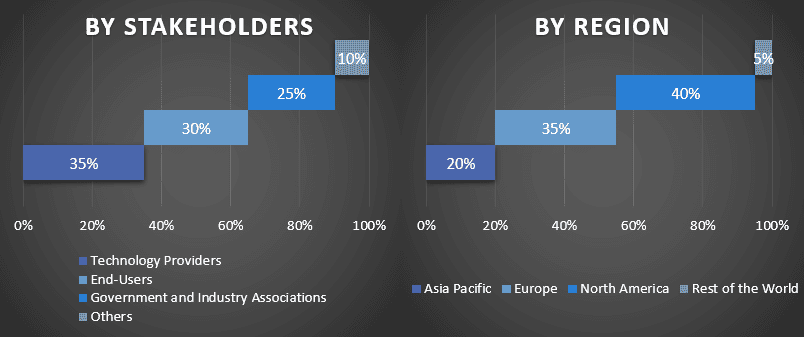- Home
- About Us
- Industry
- Services
- Reading
- Contact Us
Natural Language Processing Market: Current Analysis and Forecast (2021-2027)
Emphasis on Type (Rule-based, Statistical, Hybrid), Application (Information extraction, Machine translation, Question answering, Report generation, Others); Deployment (On-Premise, Cloud); Application (BFSI, Healthcare, IT and Telecom, Retail, Others), Region/ Country

The natural language processing market is expected to grow at a CAGR of 24.% during the forecast period. The increasing use of smart devices to promote intelligent environments is expected to impact the growth of the natural language processing (NLP) market during the forecast period. High demand for cloud-based NLP solutions to reduce overall costs and improve scalability is also expected to boost the growth of the natural language processing (NLP) market. In addition, the rapid promotion of predictive analytics to mitigate risk and identify growth opportunities can also have a positive impact on market growth. In addition, the rapid increase in scale and use of IT and automation around the world is expected to create significant demand for natural language processing (NLP) and drive growth in the natural language processing (NLP) market. Natural language processing fills the communication gap between technology and humans. With its introduction now, humans can give easily understandable instructions. It is also considered a branch of artificial intelligence that understands, interprets, and manipulates human languages.
Insights Presented in the Report
“Amongst type, the statistical segment is expected to witness the highest CAGR during the forecast period”
Based on type, the market is segmented into rule-based, statistical, and hybrid. The statistical segment is expected to hold the majority of the natural language processing market. Statistical natural language processing (NLP) intends to perform statistical inference for the field of natural language processing. Statistical NLP also enables natural conversations between chatbots and humans.
“Amongst application, the machine translation segment is expected to witness the highest CAGR during the forecast period”
Based on application, the market is segmented into information extraction, machine translation, question answering, report generation, and others. The machine translation market is expected to hold the majority of the natural language processing market owing to the rising demand in organizations for solutions that can facilitate the translation of the text into multiple languages.
“Amongst deployment, the cloud segment is expected to witness the highest CAGR during the forecast period”
Based on deployment, the market is segmented into on-premises and cloud. The cloud segment is expected to hold the majority of the natural language processing market. Cloud-based natural language processing platform enables users to utilize and analyze multilingual content, user-generated content, and other web content in a more secure manner and can access this data from anywhere in the world.
“North America to witness significant growth during the forecast period”
The North American market is expected to hold the highest CAGR during the forecast period. North America is one of the most developed regions and has heavily invested in technologies such as analytics, AI, and ML. many start-ups in the U.S. are gradually deploying natural language processing services. Furthermore, many start-up companies are entering the NLP market in the countries like the U.S. This is due to the increasing demand for AI and NLP-enabled products and solutions that are present in the market. it is the highest revenue-generating region in the global NLP market, with the US constituting the largest market share. Rapid developments in infrastructure and the high adoption of digital technologies are the major factors driving the growth of the NLP market in the region.
Reasons to buy this report:
- The study includes market sizing and forecasting analysis validated by authenticated key industry experts.
- The report presents a quick review of overall industry performance at one glance.
- The report covers an in-depth analysis of prominent industry peers with a primary focus on key business financials, product portfolios, expansion strategies, and recent developments.
- Detailed examination of drivers, restraints, key trends, and opportunities prevailing in the industry.
- The study comprehensively covers the market across different segments.
- Deep dive regional level analysis of the industry.
Customization Options:
The global natural language processing market can further be customized as per the requirement or any other market segment. Besides this, UMI understands that you may have your own business needs, hence feel free to connect with us to get a report that completely suits your requirements.
Table of Content
Research Methodology for The Global Natural Language Processing Market Analysis (2021-2027)
Analyzing the historical market, estimating the current market, and forecasting the future market of the global natural language processing market were the three major steps undertaken to create and analyze the adoption of natural language processing in major regions globally. Exhaustive secondary research was conducted to collect the historical market numbers and estimate the current market size. Secondly, to validate these insights, numerous findings and assumptions were taken into consideration. Moreover, exhaustive primary interviews were also conducted, with industry experts across the value chain of the global natural language processing market. Post assumption and validation of market numbers through primary interviews, we employed a top-down/bottom-up approach to forecasting the complete market size. Thereafter, market breakdown and data triangulation methods were adopted to estimate and analyze the market size of segments and sub-segments of the industry pertains to. Detailed methodology is explained below:
Analysis of Historical Market Size
Step 1: In-Depth Study of Secondary Sources:
Detail secondary study was conducted to obtain the historical market size of the natural language processing market through company internal sources such as annual reports & financial statements, performance presentations, press releases, etc., and external sources including journals, news & articles, government publications, competitor publications, sector reports, third-party database, and other credible publications.
Step 2: Market Segmentation:
After obtaining the historical market size of the natural language processing market, we conducted a detailed secondary analysis to gather historical market insights and share for different segments & sub-segments for major regions. Major segments are included in the report as type, application, deployment, and industry vertical. Further country-level analyses were conducted to evaluate the overall adoption of testing models in that region.
Step 3: Factor Analysis:
After acquiring the historical market size of different segments and sub-segments, we conducted a detailed factor analysis to estimate the current market size of the natural language processing market. Further, we conducted factor analysis using dependent and independent variables such as various types, application, deployment, and industry verticals of natural language processing. A thorough analysis was conducted for demand and supply-side scenarios considering top partnerships, mergers and acquisitions, business expansion, and product launches in the natural language processing market sector across the globe.
Current Market Size Estimate & Forecast
Current Market Sizing: Based on actionable insights from the above 3 steps, we arrived at the current market size, key players in the global natural language processing market, and market shares of the segments. All the required percentage shares split, and market breakdowns were determined using the above-mentioned secondary approach and were verified through primary interviews.
Estimation & Forecasting: For market estimation and forecast, weights were assigned to different factors including drivers & trends, restraints, and opportunities available for the stakeholders. After analyzing these factors, relevant forecasting techniques i.e., top-down/bottom-up approach were applied to arrive at the market forecast about 2027 for different segments and sub-segments across the major markets globally. The research methodology adopted to estimate the market size encompasses:
- The industry’s market size, in terms of revenue (USD) and the adoption rate of the natural language processing market across the major markets domestically
- All percentage shares, splits, and breakdowns of market segments and sub-segments
- Key players in the global natural language processing market in terms of solutions offered. Also, the growth strategies adopted by these players to compete in the fast-growing market
Market Size and Share Validation
Primary Research: In-depth interviews were conducted with the Key Opinion Leaders (KOLs) including Top Level Executives (CXO/VPs, Sales Head, Marketing Head, Operational Head, and Regional Head, Country Head, etc.) across major regions. Primary research findings were then summarized, and statistical analysis was performed to prove the stated hypothesis. Inputs from primary research were consolidated with secondary findings, hence turning information into actionable insights.
Split of Primary Participants in Different Regions

Market Engineering
Data triangulation technique was employed to complete the overall market estimation and to arrive at precise statistical numbers for each segment and sub-segment of the global natural language processing market. Data was split into several segments & sub-segments post studying various parameters and trends in the areas of type, application, and deployment, Industry verticals, in the global natural language processing market.
The main objective of the global natural language processing market study
The current & future market trends of the global natural language processing market were pinpointed in the study. Investors can gain strategic insights to base their discretion for investments on the qualitative and quantitative analysis performed in the study. Current and future market trends determined the overall attractiveness of the market at a regional level, providing a platform for the industrial participant to exploit the untapped market to benefit from a first-mover advantage. Other quantitative goals of the studies include:
- Analyze the current and forecast market size of the natural language processing market in terms of value (USD). Also, analyze the current and forecast market size of different segments and sub-segments
- Segments in the study include areas of type, application, deployment, and industry vertical.
- Define and analysis of the regulatory framework for the natural language processing market industry.
- Analyze the value chain involved with the presence of various intermediaries, along with analyzing customer and competitor behaviors of the industry.
- Analyze the current and forecast market size of the natural language processing market for the major region.
- Major countries of regions studied in the report include Asia Pacific, Europe, North America, and the Rest of the world.
- Company profiles of the natural language processing market and the growth strategies adopted by the market players to sustain in the fast-growing market
- Deep dive regional level analysis of the industry
Related Reports
Customers who bought this item also bought










